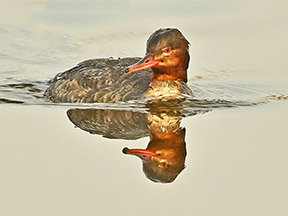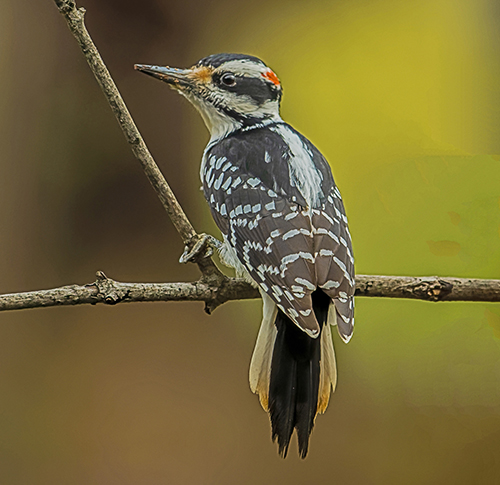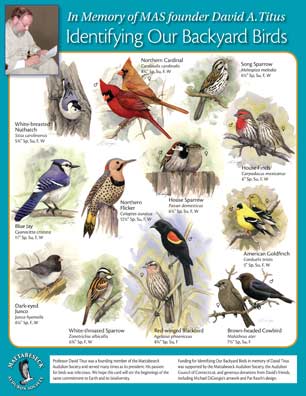
Merganzer with Reflection
Our Mission: The Mattabeseck Audubon Society, a chapter of the National Audubon
Society, is committed to environmental leadership and education for
the benefit of the community and the earth's biodiversity.
deKoven House,
27 Washington Street,
Middletown, Connecticut 06457
Visit Mattabeseck Audubon on Facebook
Field Trip Time Change:
Wildflower walk in (Guiffrida) Park will begin at 12:30 p.m. Sat., April 20, instead of 8:00 a.m., due to expected rain all morning.
Christmas Bird Count Results
Another Christmas Count is behind us! We had a very successful 49th annual count which was held on Sunday, December 17th, 2023. Our 15-mile diameter count circle center is the Comstock Covered Bridge in Colchester. 11 teams (38 birders) were in the field, and we had 10 feeder counters who submitted data from their backyards.
The weather cooperated with a minimum temperature of 35 degrees and maximum of 51 degrees by the afternoon! It felt a little strange not to need to be all bundled up. Although it was cloudy most of the day, thankfully, the precipitation held off until after sunset.
Field participants logged a total of 346 miles by car and 38 miles on foot.
Thanks to Joe Morin, Tom and Valentina Baptist we did not get skunked on owls! All the usuals were seen including Great-horned, Eastern Screech, and Barred. No one had Northern Saw-whet Owl this year. No one saw vultures on count day, but thanks to Barbi Batchelder and Carrie Conrad we were able to include Black Vulture and Turkey Vulture as “count week” species.
Carrie’s team also had Red-throated Loon on the CT River! Highlights from my team were a flock of 60 Eastern Meadowlark, 1404 Ring-necked Duck, 1 Pied-billed Grebe, and 1 American Woodcock that came within a foot of being stepped on before being flushed by a surprised Roy Dellinger.
The Salmon River Count had a total of 75 species on count day, which is a respectable number for our inland territory. Species with over 1000 individuals seen included:
Ring-necked duck (1409)
American Robin (1035)
The next most common birds were:
European Starling (866)
Canada Goose (635)
Dark-eyed Junco (528)
Blue Jay (321)
White-throated Sparrow (350)
Mallard (316)
Tufted Titmouse (272)
Black-capped Chickadee (254)
Cedar Waxwing (247)
Eastern Bluebird (230)
There were a total of 17 Bald Eagle and only 8 Wild Turkey.
Many of us gathered at Farrell’s Restaurant in Portland after our work in the field to enjoy a warm meal and share stories from the day. Many field participants have been a part of this count for ver 25 years, some since its inception!
I look forward to seeing the same faces year after year. There is great camaraderie among this group of people. That being said, we are always looking for more people to become a part of this annual tradition. Next year is the big 5-0 and we would like to make it our biggest count ever! Please help us achieve that goal. You won’t regret it!
Happy Birding!
Sharon Dellinger, Co-Compiler of Salmon River Christmas Bird Count and Secretary of Mattabeseck Audubon Society
Upcoming Field Trips for Spring/Summer 2024
Note: Our previous usual MAS trip-meeting place (SISP parking lot at Wesleyan) is unavailable. Please see field trip page for meeting places).
April 20, 2024 (Saturday TIME CHANGE: 12:30 p.m.)
Wildflower Walk in the Park
May 4, 2024 (Saturday 8 a.m.)
David Titus Memorial Warbler Walk
June 1, 2024 (Saturday, 9:00–11:00 a.m.)
I-Park Birding Walk
June 8, 2024 (Saturday 8:30 a.m.)
Canoe/Kayak Trip — Salmon River
Download Spring/Summer 2024 Wingbeat
The new issue of Wingbeat is now available for download. This .pdf file can be read on iPad, computer, and most tablets, and may be printed (letter-size pages) in color or grayscale.
To receive an emailed LINK to download each new issue as it is issued, please send your email address to pat_rasch@comcast.net and please put WINGBEAT in the message title. Issues will also be available to download anytime from our home page.
We may also send out special announcements or cancellations via email (only if we have your email address on file!)
Many thanks to George Landis for sending these gorgeous photos:

Merganzer with Reflection
.jpg)
White-throated Sparrow

Female Cardinal

Male Hairy Woodpecker
If you find a baby bird or an injured animal...
If you find a baby bird or other baby animal, it's best to leave it alone.
Chances are the parent is nearby and will take care of the baby when you
leave the area.
If you have some other wildlife problem, contact the
CT Wildlife Rehabilitators Association at http://www.cwrawildlife.org/ where you can find a rehabilitator in your area or someone to address your problem. CT DEEP dispatch phone number: 860-424-3333. CT DEEP list of wildlife rehabilitators bit.ly/2CoDTxu
Wingbeat Deadline for Next Issue
The deadline for items to be included in the Summer/Fall Issue is July 26, 2024. We expect issue to be posted to our website about August 16, 2024. Please send items to Pat Rasch, 24 Elm Road, Cromwell, CT 06416, or email to <mattabeseck@mac.com>. Please add "WINGBEAT" to the message's subject line.
Mattabeseck Audubon Needs Your Help
We need you. There is always a need for new volunteer leaders in any organization, but the past couple of years have brought losses to our board that have created even greater challenges.
We’re always looking for new board members.
Please contact us (phone / e-mail / slow mail) and let us know if you’d like to help.
 David Titus Memorial
David Titus Memorial
Bird Card—
heavy-duty laminated
plastic—only $3.00!
Our David Titus Memorial Bird Card is available for a $3 donation. Please email your request for bird cards to mattabeseck@mac.com. Bird cards are also available at any Mattabeseck-sponsored programs (but not on field trips).
Many thanks to local wildlife illustrator, Mike DiGiorgio, (www.mdigiorgio.com) for his beautiful illustrations, many of which were painted specifically for this bird card. The card is a very inexpensive way to own some of the best bird art you’ll ever see.
It is extra heavy-duty, all-plastic laminate, printed in full color on both sides. Twenty-four birds are identified by their common name and Latin name, along with the length of the bird and the seasons that they are usually seen in our area. In species that have visual differences between the sexes, both sexes are portrayed.